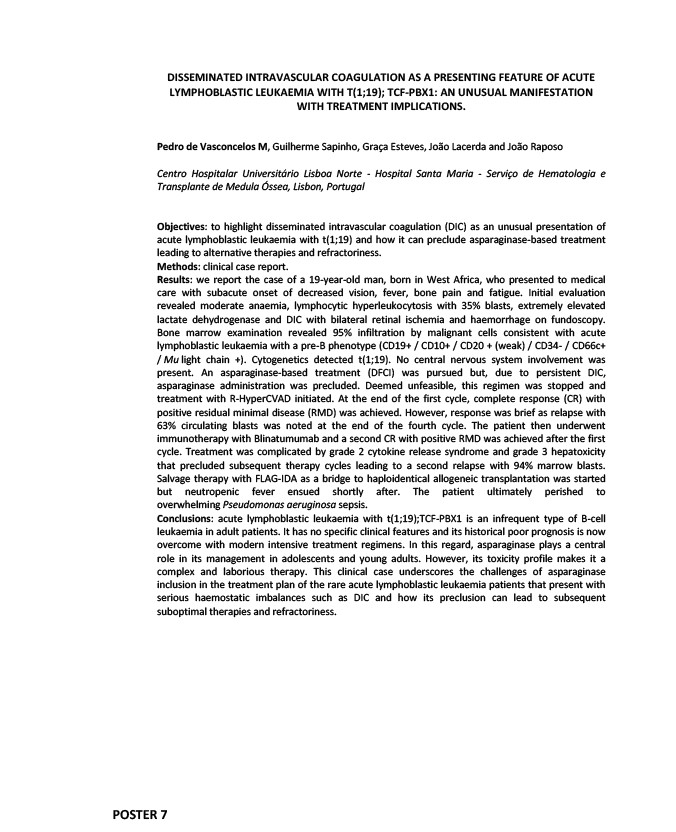
DISSEMINATED INTRAVASCULAR COAGULATION AS A PRESENTING FEATURE OF ACUTE
LYMPHOBLASTIC LEUKAEMIA WITH T(1;19); TCF-PBX1: AN UNUSUAL MANIFESTATION
POSTER 7
WITH TREATMENT IMPLICATIONS.
Pedro de Vasconcelos M, Guilherme Sapinho, Graça Esteves, João Lacerda and João Raposo
Centro Hospitalar Universitário Lisboa Norte - Hospital Santa Maria - Serviço de Hematologia e
Transplante de Medula Óssea, Lisbon, Portugal
Objectives: to highlight disseminated intravascular coagulation (DIC) as an unusual presentation of
acute lymphoblastic leukaemia with t(1;19) and how it can preclude asparaginase-based treatment
leading to alternative therapies and refractoriness.
Methods: clinical case report.
Results: we report the case of a 19-year-old man, born in West Africa, who presented to medical
care with subacute onset of decreased vision, fever, bone pain and fatigue. Initial evaluation
revealed moderate anaemia, lymphocytic hyperleukocytosis with 35% blasts, extremely elevated
lactate dehydrogenase and DIC with bilateral retinal ischemia and haemorrhage on fundoscopy.
Bone marrow examination revealed 95% infiltration by malignant cells consistent with acute
lymphoblastic leukaemia with a pre-B phenotype (CD19+ / CD10+ / CD20 + (weak) / CD34- / CD66c+
/ Mu light chain +). Cytogenetics detected t(1;19). No central nervous system involvement was
present. An asparaginase-based treatment (DFCI) was pursued but, due to persistent DIC,
asparaginase administration was precluded. Deemed unfeasible, this regimen was stopped and
treatment with R-HyperCVAD initiated. At the end of the first cycle, complete response (CR) with
positive residual minimal disease (RMD) was achieved. However, response was brief as relapse with
63% circulating blasts was noted at the end of the fourth cycle. The patient then underwent
immunotherapy with Blinatumumab and a second CR with positive RMD was achieved after the first
cycle. Treatment was complicated by grade 2 cytokine release syndrome and grade 3 hepatoxicity
that precluded subsequent therapy cycles leading to a second relapse with 94% marrow blasts.
Salvage therapy with FLAG-IDA as a bridge to haploidentical allogeneic transplantation was started
but neutropenic fever ensued shortly after. The patient ultimately perished to
overwhelming Pseudomonas aeruginosa sepsis.
Conclusions: acute lymphoblastic leukaemia with t(1;19);TCF-PBX1 is an infrequent type of B-cell
leukaemia in adult patients. It has no specific clinical features and its historical poor prognosis is now
overcome with modern intensive treatment regimens. In this regard, asparaginase plays a central
role in its management in adolescents and young adults. However, its toxicity profile makes it a
complex and laborious therapy. This clinical case underscores the challenges of asparaginase
inclusion in the treatment plan of the rare acute lymphoblastic leukaemia patients that present with
serious haemostatic imbalances such as DIC and how its preclusion can lead to subsequent
suboptimal therapies and refractoriness.